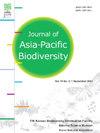The complete chloroplast genome sequence of Begonia jingxiensis (Begoniaceae): Characterization and phylogeny
IF 0.7
Q4 BIODIVERSITY CONSERVATION
引用次数: 0
Abstract
Begonia jingxiensis D. Fang & Y. G. Wei is one of Begonia species which are distributed in limestone karsts of Guangxi, China, and have important ecological and horticultural value. Here, we sequenced, assembled, and annotated the complete chloroplast genome of B. jingxiensis via Illumina sequencing technology. The chloroplast genome of B. jingxiensis was 169,711 bp in size, displayed a typical circular quadripartite structure with a large single-copy region (76,471 bp) and a small single-copy region (18,154 bp), and was separated by two inverted repeat regions (IRa/IRb; 37,543 bp). The genome encoded 140 genes, including 90 protein-coding genes, 42 transfer RNA (tRNA) genes, and eight ribosomal RNA (rRNA) genes. Phylogenetic analysis based on the complete chloroplast genome from 22 species supported that B. jingxiensis was clustered with other sect. Coelocentrum species and was a sister to Begonia umbraculifolia. This study will provide valuable genetic information for further species identification, popular genetic, diversity studies, and phylogenetic studies in the genus of Begonia.
靖西海棠(海棠科)叶绿体全基因组序列:特征与系统发育
靖西海棠;魏玉刚是分布在广西石灰岩岩溶区的海棠属植物之一,具有重要的生态和园艺价值。本研究利用Illumina测序技术对京西白杨叶绿体全基因组进行了测序、组装和注释。京西白刺叶绿体基因组大小为169,711 bp,呈典型的圆形四分体结构,单拷贝区大(76,471 bp),单拷贝区小(18,154 bp),由两个反向重复区(IRa/IRb;37543个基点)。基因组编码140个基因,包括90个蛋白质编码基因,42个转移RNA (tRNA)基因和8个核糖体RNA (rRNA)基因。基于22种植物叶绿体全基因组的系统发育分析表明,京西秋海棠与其他Coelocentrum科属属同属,是秋海棠的姊妹种。本研究将为进一步开展海棠属植物的物种鉴定、流行遗传、多样性研究和系统发育研究提供有价值的遗传信息。
本文章由计算机程序翻译,如有差异,请以英文原文为准。
求助全文
约1分钟内获得全文
求助全文
来源期刊

Journal of Asia-Pacific Biodiversity
Agricultural and Biological Sciences-Insect Science
CiteScore
1.70
自引率
12.50%
发文量
94
审稿时长
27 days
期刊介绍:
The Journal of Asia-Pacific Biodiversity (previous title was Journal of Korean Nature) is an official journal of National Science Museum of Korea (NSMK) and Korea National Arboretum (KNA). The scope of journal is wide and multidisciplinary that publishes original research papers, review articles, as well as conceptual, technical and methodological papers on all aspects of biological diversity-its description, analysis and conservation, and its application by humankind. This wide and multidisciplinary journal aims to provide both scientists and practitioners in conservation theory, policy and management with comprehensive and applicable information. However, papers should not be submitted that deal with microorganisms, except in invited paper. Articles that are focused on the social and economical aspects of biodiversity will be normally not accepted.
 求助内容:
求助内容: 应助结果提醒方式:
应助结果提醒方式:


